#may photo book challenge
Text
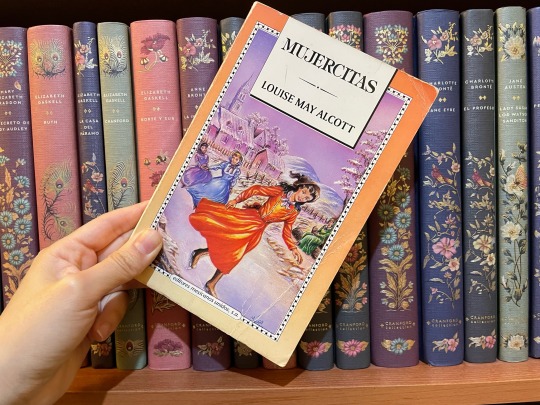
JOMP Book Photo Challenge || January || 12 || What Got You Into Reading
Little Women by Louisa May Alcott
#jompbpc#justonemorepage#book photo challenge#little women#louisa may alcott#jo march#meg march#amy march#beth march#bookshelf#book spines#booklr#books#leerreadinglire
67 notes
·
View notes
Text
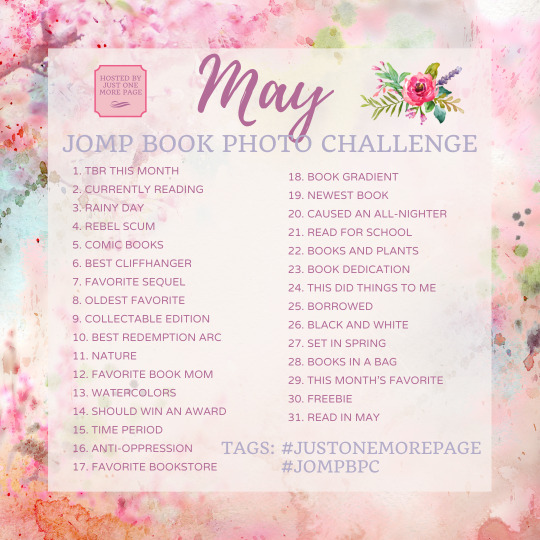
JOMP Book Photo Challenge hosted by Just One More Page 📚 📷
Month: May; Tags: #justonemorepage • #jompbpc
May is here, May is beautiful, and here's the BPC prompt for you all! 🌼💕🌼
As always, click here for the FAQ, and please feel free to ask me if you have any questions. ❤️ Enjoy!
40 notes
·
View notes
Text

JOMP Book Photo Challenge || May 24 || This Did Things To Me:
Night Watch by Terry Pratchett
#Night Watch#Terry Pratchett#justonemorepage#jompbpc#book photo challenge#book photography#books#Discworld#Reasonably Priced Love and a Hardboiled Egg#the glorious 25th of may#Not Out of Void But Out of Chaos#bpc catch up#whoops never hit post yesterday
65 notes
·
View notes
Photo
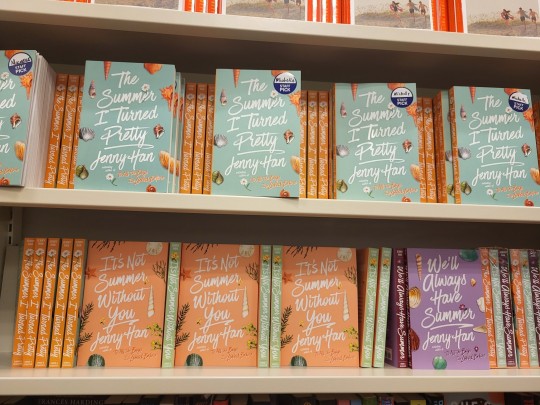
April 2023 JOMPBPC: Day 30 Freebie
#justonemorepage#jompbpc#book photo challenge#booklr#bookblr#jenny han#the summer i turned pretty#books#may 2023
23 notes
·
View notes
Text
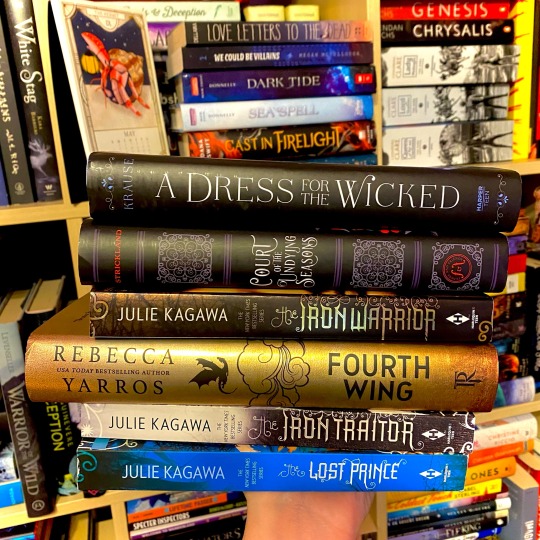
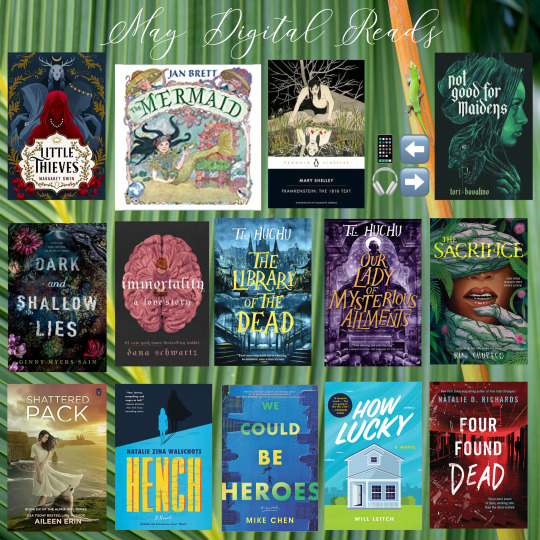
JOMP day 31
Read in May
Definitely didn’t get to many of the books on my tbr 😅 but I did manage to read 1 of my gifted books and 1 mermaid book (even though it’s technically a baby book 😂)
I enjoyed a lot of my reads this month too 🙌
11 notes
·
View notes
Text

October JOMP Day 5 - Dead Author
#justonemorepage#jompbpc#books#booklr#little women#good wives#louisa may alcott#book photo challenge#book photography#moondustbooks
0 notes
Text
Addressing Common Arguments Against “Consuming Harmful Content”
Challenging purity culture in online spaces and their fears of “problematic media”.
Read this piece on Medium. / / Leave a tip.
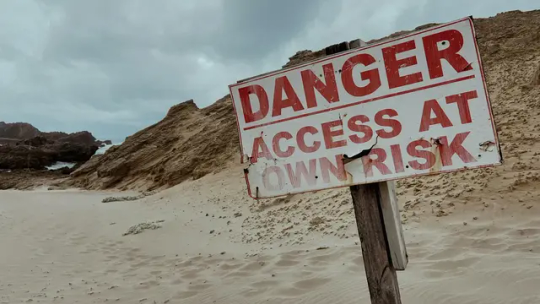
Photo by Ethan Will via Pexels.
Constant and continuous arguments endure on social media about the dreaded and frightening spectre of problematic media — from television shows that supposedly “glorify” unhealthy relationships or “sexualise” and “excuse” abusive relationships; to erotica, adult books, and 18+ fanfiction that supposedly teach teenagers bad life lessons and impact their ethics; to anime and manga that surely must be the cause of child abuse the world over.
I wrote an in-depth essay about the intellectual flaws in these reactionary assumptions, delving into their roots in lacking media literacy and rising anti-sex attitudes here:
The above essay discusses at length many of the fears and anxieties that lead to this reactionary thinking, but does not challenge or explore the echo chambers that can arise in online spaces, particularly in aggressive environments such as Twitter/X, and for young or isolated individuals who are particularly vulnerable to peer pressure and fears of ostracisation if they admit to the “wrong” opinions.
Many of these arguments are used by “anti-shippers” within fandom and online spaces, the term commonly shortened as “antis” — if you’re unfamiliar with the term, these are people who define themselves as opposing one or more specific ships, fandoms, tropes, or kinks, often due to what they perceive to be their “problematic” or inherently “harmful” elements when engaged with or portrayed in various forms of media and art. Because of the virulent and highly aggressive nature of these online communities, these people — many of them young or isolated, often marginalised and disenfranchised from in-person, supportive environments — can become radicalised, and can experience great fear and anxiety at the premise of others holding different opinions or perspectives from the ones these online communities have impressed upon them should be held immutably by all.
In this piece I’m going to be addressing common arguments and assumptions seen on social media one by one — it is not really intended to convert the above, often radicalised individuals, but to provide support and guidance in understanding why their perspectives can be flawed, and how to engage with and deconstruct those arguments.
It is also intended to provide support and structure to begin to engage with and potentially challenge or affirm your own beliefs and ideas about fiction, art, and other forms of media, and the extent of the impact it can have on you or others — this piece is me addressing these arguments with my own perspective, but I would encourage people to disagree with and critique my rebuttals!
The goal here is always more critical thought, analysis, and understanding, and that doesn’t come from automatically following another person’s line of thought or argument just because it’s well-poised or you particularly respect or like them — no matter who that person or people may be.
--
“Depicting [a theme] in media is the same as glorifying it!”
Let’s first engage with what people might be discussing when they panic about “harmful content” and “problematic” ships or pieces of fiction.
They might worry about people reading or watching works that discuss or depict anything from violence, incest, sexual assault, age gaps, BDSM, kinky sex, child sexual abuse, trauma recovery, rape, rape recovery, drug use, bestiality, to abusive relationships or anything else, will encourage people to think positively about those acts, those traumas, and those experiences.
You might look at the list of things I just wrote there and go, “Um, there are big differences between some of those things and the others!”
And yet the same consideration still applies.
Just because a theme or idea is present in a work, or is depicted in it implicitly or explicitly, doesn’t mean it’s being “glorified” and portrayed as overwhelmingly positive — and even if a theme or aspect is being glorified, this does not mean we shall simply unthinkingly absorb that perspective.
Reading a story that contains something doesn’t mean I’ll automatically think that thing is good or bad, regardless of how it’s portrayed in fiction — the media and art we engage with doesn’t wholly change and adjust our own ethics and morals as soon as we’ve interacted with it.
We might play a videogame and disagree with the way some themes are presented, have criticisms of them, whilst enjoying and appreciating others; we might read a piece of erotica and find some parts about it very hot, but find others disturbing and a little uncomfortable; we might watch a TV show and just think it’s in very poor taste, despite theoretically being up for the premise.
Engaging with media does not turn off and on switches in our brains that make us completely “pro” or completely “anti” one premise or other.
People are more complicated than that.
We have complex and layered feelings about every argument and perspective there is, every experience there is, because human beings are social animals, and we experience very few things through an uncomplicated, binary lens.
For me personally, I often seek out works that cover the same traumas and harms I’ve experienced — why? Because seeking out those themes helps me process and better understand what has happened to me, and how I’ve felt about it, how I’ve responded.
“I don’t have a problem with people writing about certain harmful topics to show them as bad, but some people sexualise or fetishise them!”
I’m sure you’re right.
Some people might write about rape to work out a complex trauma recovery narrative — others might write about rape in a work as kink. An author might well write with both goals in mind in the same work.
A traumatic event doesn’t become less traumatic because it sexually aroused us or brought us physical pleasure — in fact, those feelings can add to the impact of a trauma and the inner conflict we experience in the aftermath.
Some people undercut victims of sexual abuse by saying they “enjoyed” it, pointing out that they orgasmed or showed signs of arousal as signs they “secretly” wanted it, and these feelings can contribute heavily to shame and fear as a victim.
Sexual arousal is a bodily response. It is not consent, and it’s not an excuse for assault or abuse. Moreover, some people might feel arousal or pleasure but not be fit to consent — for example, if someone is underage, or if someone is drugged or insensible with drink.
These people cannot give knowledgeable consent, but abusers might still say after an assault that they “enjoyed” it.
This is purity culture at work — anti-sex attitudes use people’s “enjoyment” of something to undercut their autonomy and right to consent, by implying they “deserve” that abuse — abuse is abuse whether it’s sexualised or not.
But the thing is, the obverse applies.
Just as someone’s mixed feelings or sensations of pleasure during a sexual assault does not mean they consented to the assault, or because someone’s feelings of happiness and love for their abuser does not mean they deserved the abusive treatment they experienced from them, a person writing sexually or erotically about a topic, or engaging with art and narratives about that topic, does not mean they actually want that thing to happen in real life, to real people, or to themselves.
Fiction is not real life.
We watch a horror film, and it doesn’t mean we want serial killers or demons to run amok, killing teenagers or possessing their victims — similarly, just because we engage with porn or erotica that sexualises certain topics doesn’t mean we’re pro- or in favour of those topics for real people.
Rape fantasies are incredibly common, despite being highly stigmatised, and just because someone fantasises about this sort of control fantasy does not mean they actually want to abuse someone or be abused.
“It’s harmful to depict abusive or immoral characters as sexy or desirable.”
If you have never experienced abuse, manipulation, or otherwise poor treatment from someone you thought was attractive, charming, or admirable, if you’ve never been groomed by someone with whom you were enamoured, I’m very glad.
I’m happy for you, honestly.
But many of us have.
People want to believe that all abusers are evil, are ugly, are obvious from a distance, are blatant from the out. People want to believe they can “tell” someone is abusive just from a glance, and write them off — and that anyone who would or might spend time with that person is therefore “asking for it”, or “letting themselves” be abused.
In actual fact, many abusers aren’t.
Many abusers are beautiful and charming — some of them draw you in, slowly bring you closer and closer until it’s very difficult to untangle yourself from your need and craving for their approval. They ruin lives, ruin psyches, and they cause unspeakable damage to their victims.
And yes, victims often feel conflicted in the aftermath of their abuse.
Many of us hero worship or greatly respect our abusers, love them very deeply, crave their good opinion, because we are carefully groomed and manipulated, over time, into relying on their praise and their attention. For victims isolated from other sources of care and support, and especially for young children and teenagers, it can be very difficult to recognise what is happening and has happened to us.
Even after we know and understand exactly what has happened to us, and also internalised that it was wrong, we can still feel conflicted.
We are not retroactively deserving of our abuse because we crave our abusers’ good opinion, or their love, still. This instinct does not excuse or justify the abuse we’ve experienced. Victims of abuse are still victims of abuse even if we go back to our abusers, even if we “accept” or attempt to justify our abuse to others, if we try to excuse it, if we don’t ask for help.
Abuse is never the victim’s fault, no matter how imperfect we are as victims.
“Writing queer characters as abusive is bad representation!”
If we exclusively write queer characters who are perfect and unimpeachable, we’re not letting ourselves write queer characters who are fully human, with all the flaws and complexities humanity comes with.
Queer people are not less deserving of this complex representation than cishet people are — and in any case, the purpose of art and media is not exclusively to provide good representation, or to show good moral examples for others.
We create to express ourselves, to reflect the world, to critique it, laugh at it, commiserate over it, to feel our feelings, to connect and communicate with others through shared stories.
If we only let ourselves do things that might be seen as “good rep”, we rob ourselves of the ability to express ourselves as completely as we might wish to.
“If you write abusive queer characters, you’re just contributing to homophobia and bigotry in art and media!”
Queer people writing queer stories with queer villains is not the same as cishet people including queer people or queer-coded characters just to be villains. The power dynamic is completely different.
Queer writers’ writing of queer villainy is often inspired by their own experiences, including of bigotry, and the harm they might do reflects harm by society, the ways harms might be felt more keenly by their victims.
Writing queer villains as villainous because their queerness makes them (or is used as a shorthand for them being) predatory, cruel, or callous, is homophobic and is often shitty, whether people intend that or not.
But just having queer villains, having queer characters do bad or abusive things, or just have flaws?
That’s as much a part of queer humanity as having queer heroes and having queer characters do good and helpful things.
Why would you read about rape when you could read consensual non-consent?
[Consensual non-consent being a kink wherein partners agree to roleplay a non-consensual situation.]
Rape in fiction is a form of consensual non-consent.
The fictional characters, who are not real and do not have real feelings, are not consenting, but the reader choosing to read is.
In the same way that two people playing a CNC roleplay game in the bedroom might be a safe and fun way of experiencing or re-experiencing the fear and trauma of assault with an escape clause (a safeword), a reader can do the same — they can stop reading.
If a television show, film, or videogame becomes upsetting, again, one can stop watching, stop playing. It is a person’s own responsibility to set safe boundaries for themselves and protect their own mental health.
“Why would someone write about trauma and abuse when they could write fluff?”
Why would someone watch a horror movie when they could watch a romcom? Why would someone eat cheese when chocolate is an option?
People do not have to choose one or the other — many people like both horror films and romcoms, cheese and chocolate, and reading about both horrible shit and positive things.
“You mentioned that people might engage with media about dark topics to work through their feelings from their own abuse. How do I know if someone’s actually been abused?”
Why do you think it’s your right to ask that?
Why are you prioritising your personal comfort and curiosity over that person’s privacy? If your instinct is to try to license who is and isn’t allowed to engage with a piece of art or media, why?
You are never entitled to the details of someone else’s abuse. Your validation is not important enough to potentially trade for someone’s private traumas and experiences.
“If you write or create about certain topics as a survivor, you’re just perpetuating abuse and you are as bad as your abuser!”
Creating works of art or fiction about people who are not real experiencing fictional harm that is also not real, is not in any way equivalent to real people doing real harm to others.
If your support of abuse survivors hinges on how palatable their reaction to their abuse is, and you believe that some abuse survivors “deserve” their abuse for depicting their abuse in art and fiction, you’re not actually supporting survivors.
If you believe that all abuse survivors do or should act the same way, or respond the same way, to their abuses, you are mistaken.
If you are effectively angry at someone for not looking enough like a victim, for being “impure”, and therefore the same as their abuser, that is a form of victim blaming.
Do you hold artists who create media about non-sexual trauma or violence to a different standard than those who write about sexual trauma or violence?
Why? What is the difference to you?
If someone writing about sexual abuse in media is equivalent to real life abuse, is a fictional murder?
“People shouldn’t write or engage with media about traumatic things, they should just go to therapy!”
Therapy is not a moral machine where bad people with bad thoughts go in and good people with good thoughts go in.
Good therapy and counselling provides us with the tools to manage our own mental health, our own emotional and psychological needs, heal from our traumas, and so forth.
Many therapists will actually recommend safe re-exposure to frightening or upsetting topics, and also encourage self-expression on the subject of one’s most impactful experiences, which might include creating art and media to explore and discuss their feelings.
With that said, therapy is as flawed as any other tools for emotional catharsis and healing — therapy and mental healthcare can be very expensive or inaccessible because of one’s working schedule; some therapists and mental health professionals are abusive or bigoted; some people may not be in the right place for MH care or therapy at this time, et cetera.
Therapy isn’t a catch-all for anything you disapprove of in someone else, and it’s also not a punishment to force someone to repent for their sins.
“It’s okay to write a story to cope, but you shouldn’t publish it in case it upsets others!”
So long as the work has appropriate content warnings and/or is published or screened in an appropriate space, it is not inherently harmful. In fact, reading narratives and engaging with those narratives can be valuable for us.
Engaging with media that bears similarity to our own lives, reflects our own experiences, written by other people who we know understand the complicated emotions of survivors — whilst still condemning the actions of abusers or not — can be extremely validating and offer a lot of assurance.
This is especially useful in regards to media that shows victims having a codependent relationship with or still loving their abusers, or where their abusers are shown as sympathetic, whilst the narrative still shows the toxicity and pain caused by the relationship.
Moreover, there can be a sense of reclamation and security in exploring stories about similar harm as we’ve experienced whilst knowing we are now in a place of safety and are free from those past experiences, or that other survivors have escaped and we can too.
“If children read this work or watch this show or play this game, they might think that the things depicted in it are okay!”
Is the work rated G or PG?
Is it shown on a children’s TV channel, or appear in a section that is marked for children? Is it put on a children’s website, where the primary audience is children?
In short, is the work aimed at kids?
If no, then it’s not for kids.
Particularly if a work is marked for adult audiences only, if it’s labelled erotica, if it’s marked M or E or NC-17, if it says it’s for adults or asks people to check a box agreeing that they’re an adult, then the work in question is most definitely not for children.
Everything in the world doesn’t have to be child-safe just because children exist.
It is the responsibility of parents and guardians to appropriately supervise their children’s online use, and to teach children and teenagers internet safety, some of which includes setting appropriate boundaries for themselves and not seeking out content that might distress them, or to know what to do if they stumble across content that does distress them — namely, to speak with a trusted adult about their feelings and what they can do to manage them and look after themselves, and be looked after.
It’s not the responsibility of random other adults in the world not to make horror movies or watch porn or play adult videogames or anything else, just because a child could potentially learn of their existence.
“But someone else engaging with that work might think the things depicted in it are okay!”
You’re right, they might do.
They might also engage with the work and think things depicted in it are bad. Fiction does not exclusively exist for our moral education.
“It makes me feel uncomfortable or unsafe that people are writing about [a topic] with a tone or in a manner that seems wrong to me!”
Yes, many of us feel uncomfortable with some topics being depicted in fiction, and might find them viscerally disgusting or triggering, consider them to be in poor taste, badly considered, or similar.
This is normal and okay.
It’s perfectly natural to have limits on what one can handle in fiction, or to find your ethical considerations don’t match up with the things other people make.
But it’s our job, as responsible adults who look after our own mental health and consider our own boundaries, to avoid that content.
You cannot control what other people think about, feel about certain topics, or how they portray them in fiction. You cannot control other people.
You can only control your environment, your boundaries, and the works you choose to engage with.
You can limit your time on social media, mute tags or keywords, block particular users or sites, or simply look away or leave the room / close the tab.
“What about rampant problematic works on Ao3!?”
Works on Ao3 are not a real issue.
They are not representation. Fanworks and original works on Ao3 are not the mainstream. They are being read exclusively by members of various internet subcultures who read fanfiction in those specific fandoms, after reading the tags.
This doesn’t mean we can’t or shouldn’t discuss certain tropes and norms in various fandoms — we might address our own biases around race, sexuality, religion, disability, and other characteristics, and how these biases and bigotries can come across in people’s approaches to fandom, the characters and ships they concentrate on, their headcanons, et cetera.
The same can be said of people’s original creations.
Ao3 has a robust tagging system, and allows people to mute and block tags they might be upset or triggered by — and in the event one clicks on an explicit work, a window will come up asking people to consent explicitly to moving through to read the work.
It is people’s own responsibility to set their own limits as to what they can handle in reading fiction — and not to obsess over what other people might or might not be reading, which we cannot control, and is also none of our business.
“What about loli and shotacon? Isn’t that the same as child pornography?”
“Child pornography” is generally not in use as a term — many people who have been victimised find that terms like “child porn” and CP grate, because “pornography” is work made with willing, adult participants.
Videos and images produced of children are instead referred to either as CSAM — child sexual abuse materials — or CSEM — child sexual exploitation materials. CSEM is evil because it involves the unspeakable and agonising victimisation of a real life child or children, being abused and manipulated by adults around them, and worse than that initial victimisation, the recording their abuse is another victimisation in itself.
With every share of a piece of this material, that child or children are victimised another time, made vulnerable to more people, and the creation of this material can create more market desire, meaning that other abusers will encourage further abuse and recording of these children’s victimisation, or for the recording abusers to seek out other children to abuse.
Victims of this sort of exploitation live in terror of the pictures or videos of their worst moments being shared to those they know, of being found by their loved ones, shared to workplaces, disseminated in any community they try to live in and be happy with — it is difficult enough to recover from one’s own abuse without the spectre of it constantly hanging over one’s head.
People’s cartoons or art of fictional children is not equivalent to CSEM, because there are no real children depicted in it.
It’s understandable to find these works disgusting or upsetting, triggering, unsettling — but to say that underage art or fiction is the same as or counts as CSEM is patently untrue. As a victim of CSA, it is galling to be told that choices my abuser made to harm and exploit me are equivalent to an abuser choosing to draw or read a comic about a victim that doesn’t actually exist.
Some final questions to ask yourself:
None of the above rebuttals are intended to imply people shouldn’t critique or criticise different media or their depictions.
As well as the initial essay I linked, I actually wrote a big guide on how to approach close reading of text, and I’m working on another about analysing television and film.
In my opinion, it’s really important to be aware of different tropes and themes that you feel are harmful in fiction and art — racist tropes, sexist ones, homophobic ones, and all the rest.
It’s worth considering how works are harmful, and what you actually want to be done about it.
I personally have criticisms of various tropes in media — I have particular dislike, for example, for the ways in which teacher/student relationships in TV shows and films are portrayed as “forbidden love”, with issue of their positions of power being depicted as one of bureaucracy or technical rules rather than a real power imbalance — I don’t care for the “sexy schoolgirl” trope, and the “barely legal” porn genre unsettles me.
All of the above three tropes often coincide with people’s thinking of teenage girls, especially those in school uniforms, as sex objects, and portraying school uniforms themselves as sexual or deserving of this sort of sexual attention.
Not all depictions are the same — some works subvert the sexy schoolgirl trope by having those schoolgirls be secret monsters than punish abusers, and some works exist that critique teacher/student dynamics.
It’s also important to note audience and outreach — a work that’s put on mainstream television channels or put in movie theatres by huge studios have a very different range of impact than an indie published novella, or one person’s fanfic on Ao3.
Note where you’re holding individual or small studio creators — especially those who are in some way marginalised and are already facing adversity in their work — to higher account than large studios, or fixating on imagined harm their work could potentially cause.
Is a work harmful, or is it just uncomfortable? Is it harmful, or is it just personally triggering to you?
Can the work you’re concerned about do as much harm as you’re envisaging? Is it actually reaching the individuals you are worried might be vulnerable to harm as a result of it? Does the work intend to do that harm or hold those harmful views, and are the authors or creators working to address or apologise for that harm?
Is the work discussing, critiquing, or exploring the emotional impact of the dark themes within it? Does it have warnings or disclaimers before the work begins?
If you’re worried about a work “normalising” or “glorifying” a troubling subject — does the work actually do that? What is your evidence for this, having engaged with the text? Is that thing discussed in the text, argued, explored in-depth, or merely mentioned? Do characters show inner conflict and interpersonal conflict over it? Is it actually portrayed as good or normal? Is your concern the characters’ perspectives within the text, or the authors or creators’ opinions?
Does the work carry ideas that are bigoted or feel like it includes apologism for some shitty ideas or ideology? Is the work a piece of propaganda, or function as propaganda? Do you feel the work is being advertised or pushed to an inappropriate audience for its subject matter?
If you do consider the work to be either likely to be personally distressing or upsetting to you, or potentially harmful because of its troubling or bigoted or just shitty ideas, how do you want to respond?
If it’s the former, you should set your own boundaries — you should use your mute and block functions, you should avoid the work, you should seek out things that will comfort you, and perhaps discuss the distressing topics with someone you trust, whether that’s a friend or partner, a loved one, or a counsellor or therapist.
If it’s the latter, you should absolutely deconstruct the piece in question and analyse the ways in which it’s shitty or harmful, or read essays by those who’ve done that work. You can maybe warn your friends about it, or if it’s a work of political concern — if the harm is being done because the work provides financial support to a hate group or a bigoted public persona, for example, you might perform a boycott, or involve yourself in acts of protest in response to the work or its creators.
If it’s important enough to you and your beliefs that you feel urged to do those things, perhaps you should — if all you feel urged to do is to harass or shout at people online, though, it might be better for your own mental health to take a step back and do something more positive for yourself.
Sometimes, a piece of work or media will be shitty, and shitty people will love it, and that will kinda suck — God knows I’ll see work that’s really transphobic or homophobic or antisemitic, and it’ll upset me that people I otherwise love and respect seem to be enjoying it so much.
I can talk to my friends and my family about it, and I’ll do that — and I can mute and block the topic, and critique it in the right circles, or write essays if I’m really inspired to, responding to the work and what I feel its impact is…
But if my instinct becomes to just snipe at people for enjoying it when they really don’t know what the problem is, or have a go at them when they’re doing so unthinkingly, that’s not really helpful to them or to myself. It’s not addressing the harm I feel is being done, and nor is it really constructive.
I’m an adult, after all — as I’ve said a few times already, it’s our own responsibility to set our own boundaries and consider what we’re doing to safeguard ourselves, and if in setting those boundaries and personal safeguarding limits, whether they’re in line with our own ethics and morality.
We cannot control other people and their feelings, or the works they create, but we can take care of ourselves, including breaking ourselves out of obsessive moral spirals or anxieties about other people’s thoughts — and personally, I think that’s actually a very revolutionary thing to do given that we exist in a world that constantly tries to encourage (and monetise) that sort of aimless outrage.
553 notes
·
View notes
Note
Can i get romance hcs for Kieran?
Ask and you shall receive! I have so many requests but I couldn't resist doing this one! Do hope I fit the bill for this one as Kieran is an, interesting character to write for 💜
Pokémon Headcannons | Kieran (Romance)
Pokémon Scarlett and Violet DLC Spoilers ahead!
Warnings: Possessive behaviour; obsession
SPOILER WARNING For Teal Mask and The Indigo Disk
------------------------------------------------------------------------------

(Was gonna use one of his Teal mask mission photos but i love this one to much not to use it. Straight up mood.)
When you step into his life, it is you and you alone who rules his heart.
Kieran’s drive for things is strong, very strong. And when he sets his mind on something; he will never stop until he’s achieved whatever it is he’s after. So when he set eyes on you, his goal was to give his all to you. And hope you will give your all to him.
Your Agias and Kieran are like siblings, he's the quiet one, Agias is the give me your food or else one
He will never force you to do anything you don’t want to. After the Ogerpon situation, Kieran spiralled into a state where he no longer felt danger. He would dive into every challenge head first, fight every trainer, every Pokémon and climb the most dangerous of mountains if it meant he could be the best. But when he’s with you, he’ll dial it back. Always staying within your comfort zone, the last thing he wants is to push the most precious thing in his life away from him.
Gets jealous incredibly easily. ESPECIALLY if it's Drayton. The Rivalry between these two is uncanny, it would be no surprise if Kieran felt true hatred towards him for a time. Though it's gone now. The jealousy of even seeing Drayton standing close to you is overbearing.
You and Carmine are practically best friends. You're the glue that keeps the pair bonded together.. When you are around Carmine doesn’t feel afraid of Kieran as you bring out her little brother, the brother she thought was lost to obsession.
If you are a member of the BB League, he will be a lot sweeter for you. He may get frazzled when the rest of the group is around and everyone is slacking off. But he will always apologise to you if you tell him he’s gone too far. Never to the others however. Even if you force him to, he’ll never mean it.
Is not an outdoor person, even with the yelling and the confidence, deep down he is still the same shy, excitable boy who just needs a hug. So his ideal time with you is sitting together and watching movies, or reading books.
He is a listener. He will listen to you for however long you need him to. Every word you say he will listen.
He isn’t good with words, even after everything that happened with Ogerpon and Terapagos. So he tends to be a lot more handsy, always trying to hold your hand, your arm, or just you in general.
Speaking of that, when out in public together, he practically is stuck to you, he eyes glaring towards anyone who shows you any form of interest, hand on his Hydrapple’s Pokeball just in case they don’t take his death stare to literal.
He’s a cheek kisser, deep down he is still extremely shy and closeted, so kissing you on the lips can fluster him even when he's the champion, so he uses cheek kisses as his way of saying he loves you.
Hug him please. He will melt. This poor boy needs a break from everything.
If he was a ship, you are his lighthouse. If you were a tree, he is your roots. You both complete each other.
When Kieran begins his ‘redemption arc’ he tries to redeem his actions slowly though he doesn’t exactly know the best way around it. So he asks for your opinions on basically everything he does. Carmine attempts to give input but as sibling rivalries go, it falls upon deaf ears.
His Hydrapple loves you, almost as much as Kieran does. Almost.
#pokemon#kieran#rival kieran#kieran pokemon#kieran x mc#pokemon dlc#pokemon indigo disk#dlc#fanfic#pokemon spoilers#pokemon sv spoilers#drayton#carmine#headcanon#romance#the teal mask#pokemon scarlet and violet#angst#obsessive love#obsession#pokemon fanfiction#pokemon x reader#possessive#drayton pokemon#fluff#gn reader
403 notes
·
View notes
Text
Eileen Prince
I'm relentlessly curious about how a witch from Slytherin, a house that values cunning and ambition on paper, and bloodlines/nobility in its culture, ended up living in a muggle slum.
Unfortunately for me, she's a barely mentioned character written by an author who consistently fails to portray female characters with depth or dimension. The women in Harry Potter are portrayed as either maternal or villains, or, in Ginny Weasley's case, as redeemed by their masculine traits (because Rowling's Thatcher era feminism dictates that equality for women = emulating patriarchal ideas of manhood). About as much as you can expect from an author who's as unable to acknowledge the personhood of trans women as she is to write women as actual people. This leaves a lot of room for interpreting or delving into what Eileen Prince's life may have looked like, and how that would have affected her son's development.
There are three direct mentions of Eileen in the text :
“The picture showed a skinny girl of around fifteen. She was not pretty; she looked simultaneously cross and sullen, with heavy brows and a long, pallid face. Underneath the photograph was the caption: Eileen Prince, Captain of the Hogwarts Gobstones Team.”
HBP Ch. 25
“I was going through the rest of the old Prophets and there was a tiny announcement about Eileen Prince marrying a man called Tobias Snape, and then later an announcement saying that she’d given birth to a" “ — murderer,” spat Harry.
HBP ch. 30
“Harry looked around: he was on platform nine and three-quarters, and Snape stood beside him, slightly hunched, next to a thin, sallow-faced, sour-looking woman who greatly resembled him.”
DH Ch. 33
(Shoutout to Harry James Potter, who didn't recognize Eileen's fifth year photo despite her resemblance to Snape, the teacher whose classroom he got his used Potions book from. Shoutout also to Harry James Potter who didn't connect the dots between the Prince's handwriting and Snape's, a teacher who regularly wrote instructions on the board. "I needed to make the plot work, ok?" - JK Rowling, probably.)
Other relevant excerpts:
“Snape staggered - his wand flew upwards, away from Harry - and suddenly Harry’s mind was teeming with memories that were not his: a hook-nosed man was shouting at a cowering woman, while a small dark-haired boy cried in a corner ”
OoTP Ch. 26
“Harry delved into his trunk and pulled out his copy of Advanced Potion-Making before getting into bed. There he turned its pages, searching, until he finally found, at the front of the book, the date that it had been published. It was nearly fifty years old.”
HBP Ch. 16
Supplemental material re: Gobstones from JK Rowling:
"...it remains a minority sport within the wizarding world, and does not enjoy a very ‘cool’ reputation, something its devotees tend to resent. Gobstones is most popular among very young wizards and witches, but they generally ‘grow out’ of the game, becoming more interested in Quidditch as they grow older. ... Gobstones enjoys limited popularity at Hogwarts, ranking low among recreational activities, way behind Quidditch and even Wizarding Chess." [There's an additional sentence on the Harry Potter wiki's Gobstones page: "...it is also known as 'the thinking wizard's Quidditch.'"]
A few conclusions can be drawn from what little information we're given about Eileen:
She's described as "cross and sullen" around the age of 15, and as "sallow-faced, sour-looking" when she's older.
She's captain of the Gobstones club around her fifth year, so she likely marched to the beat of her own drum - given that Gobstones isn't particularly popular - and owns it proudly enough to take, or even seek out, a leadership role.
The sport is described as "the thinking wizard's Quidditch" which would imply Eileen was more interested in intellectual challenges and was clever (and can be paralleled with a young Severus' comment about "if you'd rather be brawny than brainy" to James Potter when they first meet on the Hogwarts Express).
Her marriage and the birth of her son are both announced in the paper, which might mean the family she came from was of some importance or note, or perhaps something else... but we'll get to that.
If we assume that Severus' secondhand copy of Advanced Potion Making was originally Eileen's (reasonable, though there is no textual evidence) then its publication date is likely around the time she was a sixth year, given that this particular text was specific to students beginning to prep for N.E.W.T. exams. Harry begins his sixth year in 1996 when the book is "nearly fifty years old," so we can assume Eileen was 16 years old sometime not long after 1946. Severus was born in 1960, which would mean Eileen was in her mid-late 20s at the time.
Her marriage was dysfunctional at best, abusive at worst. As per a Pottermore post that is still up on WizardingWorld.com: "...the desperately lonely and unhappy childhood [Severus] had with a harsh father who didn’t hold back when it came to the whip." Based on this, we can assume Tobias was abusive, and given Eileen's cowering as he shouted at her, she presumably feared him.
From these bits of information emerges the image of a woman who either had a surly personality, or at the very least was guarded, though perhaps just formal. There isn't really any difference in how her face is set when she's in an everyday setting like King's Cross, or when she's having her picture taken for the Gobstones Club. It's possible she was a stern, unsmiling person, but it's also possible - given that her wedding and child were announced in the paper - that she came from a family of some standing and was raised to conduct herself with hallmarks of British class, such as dignity and unaffectedness. After all, there are several wizarding families - such as the Potters - who are wealthy purebloods with social standing but are not part of the Sacred 28. Additionally, the Gobstones Club portrait would have been taken around the mid-1940s, when portraits were formal and their subjects did not often smile, and given that we see only a snippet of Eileen, we don't have enough information that she was unhappy or sour. It's also important to remember that we see her portrait and Snape's memory of her through Harry's perspective and, like his perception of Snape himself, this may convey Harry's biases.
We also know from the text that Snape had a house in a deserted part of Cokeworth, a fictional Midlands town that presumably had a collapsed milling industry, at the end of a street called Spinner's End. There's a great thread that goes into details about the kind of 2 up 2 down house it would have been, and we can assume that this is Snape's family home given that we know he and Lily grew up in Cokeworth. For all intents and purposes, the conclusion we can draw from this being the Snape family's home in the 60s is that they were working class and cripplingly poor. Most estates like this had been cleared by the 60s, and no longer exist today.
This begs the question: how did a witch from a possibly well-off family end up in an abusive marriage in an irrelevant slum?
Buckle up kids, we're leaving the world of textual references and veering into deep meta territory now. I won't label any of this as head canon because I'm not set on these interpretations, and am just drawing conclusions from the text, but some of it may be a bit loose even for meta.
If Eileen was 16 years old not long after 1946, then she would have finished school in the late 40s, possibly even 1950. While some people (including past me) posit the theory that Tobias may have been injured in WWII and his injuries debilitated him, forcing him to go on the dole and affecting his mental health, I'm increasingly skeptical of this theory. It would make more sense if Eileen had known him before he was drafted/enlisted and had committed to a relationship with him, which would then have changed when he came back from the war and was altered. If we assume Eileen's age based on the idea that it was her own copy of Advanced Potion Making Severus used, then she would still have been at school during WWII (which makes an interesting parallel with Severus' own experience of spending the bulk of the first wizarding war against Voldemort as a student at school).
I do think, however, that there's merit in the theory that Tobias suffered some kind of altering injury and that he wasn't necessarily abusive before Eileen committed herself to him. It makes little sense for a Slytherin graduate who was confident and self-posessed enough to be the face of an unpopular club to be drawn to a partner so abusive his shouts caused her to cower and who whipped his child freely. If, however, he was a charming, happy man when they met who suffered a life-altering injury, the trauma of which left him a shell of his former self, then someone like Eileen might stick around for the sake of the parts of his old self she can still see in him.
It's interesting that she didn't seem to use her magic to protect herself or her son, or even to dress her son in clothing that fit, but we know from the text that depression can cause a wizard's powers to wane:
“...it is also possible that her unrequited love and the attendant despair sapped her of her powers; that can happen”
HBP Ch. 13 (Dumbledore talking about Merope Gaunt)
The fact that the Snapes retained the house in Spinner's End seems to indicate that they continued to live there even when the local industry dried up and the slum was cleared as workers were moved to other parts of the country where they were needed (presumably what happened given *gestures at British history*). The most likely explanation for this would be that Tobias wasn't able to work, and perhaps did suffer an injury, only it was at work, and not during the war. This would mean the family lived on the dole (ie. welfare) and also that he would have spent a lot more time at home. It would also explain his anger and frustration that led to abusive behavior (which isn't to say that disabled people are abusive by any means, but it would have been emasculating for a man who considered himself the breadwinner in the 60s, and chronic pain coupled with limited abilities would give anyone a short fuse).
Moreover, this living situation seems to indicate that there is no additional support coming from anywhere. Where is Eileen's family? Why were they not helping? There's no indication in the text that there is any connection with them at all. We can infer from Snape's memories that, as a child, he learned what he knew about the magical world from his mother. This implies that she talked to him about it a fair amount, and his conviction that he and Lily were going to Hogwarts well before they got their letters also implies that Eileen expected him to go there and was set on her son having a magical education, despite how little she seemed to use her own powers.
Severus knows a lot about the wizarding world as a child, including that prisoners are sent to Azkaban and that it's guarded by Dementors, Hogwarts' house structure and what to expect when he and Lily get there, and about the Statute of Secrecy and the laws around it. When Lily asks him if it makes a difference being Muggleborn, Severus hesitates before replying no, presumably because he's aware of pureblood bias being a part of wizarding culture.
Perhaps that's the reason Eileen's family doesn't seem to be in the picture. My own theory is that Eileen hadn't planned to commit herself to Tobias long-term, and Severus was an accidental outcome of an innocent tryst in which a young Eileen, an educated witch from a well to do pureblood family, was having fun slumming it with a working class muggle and ended up pregnant. While we don't know the wizarding world's attitude around pregnancy and abortion, we do know it's a conservative and classist society that parallels muggle British culture fairly closely, and that the late 50s/early 60s were a time when an out of wedlock baby would have been considered a disgrace.
Add to that the anti-muggle bias of a pureblood family and it sounds like Eileen was disowned her for her mistake (and don't @ me, but even though I know that not all Slytherins are purebloods, it does seem to be a persistent cultural value of the house reaching back to Salazar Slytherin himself, so Eileen's being sorted into it can reasonably be taken as an indication of her blood status). Perhaps the marriage and birth announcements in the Daily Prophet were put in by Eileen herself, if she was a woman from a family where this was customary. It may have been her way of letting her family know of the events, or even of asserting herself and even deliberately defying them, announcing to the whole wizarding world that a Prince married and had a child with a muggle. It makes sense that the girl who wasn't just in the Gobstones club, but became captain, would also say to herself, why shouldn't I have my marriage announced in the paper like everyone else in the family?
It's worth noting that mid-late 20s is pretty young to have a baby in the wizarding world, where the life expectancy and child bearing years are much longer than they are for a muggle. According to the Harry Potter wiki:
"Wizard life expectancy in Britain reached an average 137¾ years in the mid-1990s, according to the Ministry of Divine Health ... Wizards in general have a much longer life expectancy than Muggles, usually living two or three times as long as their non magical counterparts, some living even longer than that depending on circumstances.
In addition, seeing as James Potter's parents had him "late in life,” witches likely have significantly longer childbearing years than Muggle women."
Although we see several characters in Severus' generation getting married and having kids not long after leaving school, there's a mention in the text that a lot of people were doing this during Voldemort's reign, as the fear he inspired made people more eager to get a move on with life since they thought they might die any day (I think Mrs. Weasley says this but I can't find the quote, @ me if you do). It's clear this wasn't the norm in the wizarding world. Eileen was a Slytherin, a house that values cunning, ambition, and strong wizarding heritage. Something must have gone very wrong in Eileen's life for her to end up having a child so young and living in a muggle slum.
And so it's possible Eileen Prince found herself pregnant and alone, having been disowned by her family to save face in light of her disgrace, and dependent on the only person she was still close to, the father of her child. It's the kind of storyline that Rowling would write, and it would parallel fairly closely the story of Voldemort's mother, thus adding another to the long list of similarities between Voldemort and Snape.
Lorrie Kim makes an interesting point when she talks about how Snape has a strong reaction to other people having a love life or romantic experiences (the context being Rowling's intention of his love for Lily being romantic and unrequited), but doesn't react particularly strongly to mothers sacrificing themselves for their children, whereas Voldemort does. Her insight, and I think it's a reasonable one, is that Severus accepts the idea of mothers making sacrifices for their children, whether it's Lily giving her life for Harry or Narcissa risking all she did to ask for his help in protecting Draco, because his own mother protected him from his father as much as she could.
There's a lot of room for interpretation on what Eileen's relationship with her son looked like, and what it says about her own state. She may have prioritized not angering Tobias to protect Severus, who as a child might have perceived her actions as a form of rejection. At the same time, she seems to have prepared him thoroughly for life in the magical world, perhaps in the hope that he would find his place in it and escape home. Perhaps she missed it and told him so much about it so she could live through her own memories.
The only time we see her argue with Tobias, in Severus' memory, she's cowering as he shouts. We know from JK Rowling that Tobias used corporal punishment liberally, which implies Eileen didn't stop him despite her magical abilities. We also see in the text, however, that while at school Severus stood up for himself against bullies and fought back, and that he was an exceptionally clever and powerful wizard. As an adult he was brave enough to face Dumbledore when he betrayed Voldemort, and later fought against Voldemort right under his nose (or lack thereof). So it stands to reason that at some point Severus began to stand up against Tobias too.
How much of that was Eileen's influence, or the result of Severus seeing her acceptance of her fate and rejecting it for himself, is hard to say. As for what happened to Tobias and Eileen that their house was Severus' by the mid-90s and they were nowhere in sight, I don't think there's enough information in the text to infer.
347 notes
·
View notes
Text
How To Be A Father

This was meant to be a shorter one but it seems to have gotten away from me, I hope you enjoy! I’ve got a special one coming later this week! Gonna do a little epistolary/diary multi TF to celebrate 500 Followers !! - Occam

Franklin’s older brother, Jack, was a soon-to-be dad, he is terribly nervous about raising a kid, as anyone should be. Franklin was looking for some way he could show his support. His eyes scan the shelves of the local bookstore, sure that there must be something of use in the advice section. He has only just graduated university and remains in a sea of uncertainty but at the very least he could buy his brother some pittance of a self-help book.
There wasn’t exactly a sea of options available, many of them were clearly religious, some were on raising children in other cultures, one particularly gaudy one was a guide on rearing the perfect American citizen. Franklin prepared to throw in the towel and order a book to be delivered, before at the end of the aisle he saw a simple clear cover, upon which was written, “How To Be A Father.” It didn’t even have the author’s name on the front. Franklin couldn’t help but let his interest be piqued as he goes to pick it up.
As he does so it’s almost as if the lights of the store dim as the monochrome cover continues to call out to him. Before checking the contents he checks the back looking for any hint of what lies between the pages and finds another completely featureless page. At this point Franklin’s eyes would usually roll as he returns this obnoxious marketing mishap to the shelf, but instead his brows furrow. He simply must know what is inside. He rushes to open to the first page as his mind can only obsessively demand the contents of the book.
He opens to the middle of the guide, stumbling on a photo of what may as well be the platonic ideal of man. Franklin’s stomach lurches in discomfort, his heart pangs knowing he could never be such a man, as the image in front of him. His eyes trace the jawline defined even through a dense beard. He hungers to be even a hundredth as masculine as the imagine in front of him. Franklin glances at the next page hoping for some recipe to be just like him, rubbing his hairless jaw as he turns eyes blurring as he reads the sentence:
"A Real Father Is Strong."

He audibly grunts as he reads the sentence and holds that exemplar of man in his mind. He doesn’t dare desire to be a father, but strength. How could he not want that? He looks down the page hoping for work out tips but his eyes find no purchase as the words blur together. Nevertheless he stares at the smudges, willing them to give him answers, as the book begins to work its own will unto him.
Franklin has spent little time on his body. It has never been a priority for him, and yet now he wants strength? The book grows warm in his hands as his eyes roll back. He bites his lip as he feels the warmth begin to surge from the book into his arms. Veins begin to bulge in his hands as they continue up his arms. His hands grow calluses from day after day of lifting iron. His forearms burst forth growing to a size larger than his calves are currently. He feels his shirt soon grow tight around his biceps as muscle begins to bulge. Thick veins appear down the direct center of his arms as he is overcome with pleasure.
The strength does not stop flowing into him as his arms start to rip open his sleeves however. Just as soon as his massive biceps make room for themselves his chest begins to demand its own attention. Muscles that he didn’t even know he had cramp on his chest as pecs burst out of his chest shooting buttons down the aisle. Just after this he feels his back expand similarly giving him a wingspan he never dreamed he could achieve. His knees buckle as he feels the warmth force itself into his lower body.
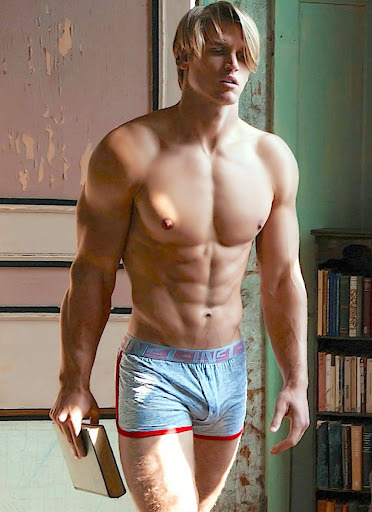
He slams to the floor loudly as his growing limbs fall out from under him. Sensing challenge from the forearms his calves rip holes into his pants as they reach a size and definition of a bodybuilder and his thighs swiftly follow suit creating a tear from his waist down to his feet, fully exposing Franklin’s lower body as he struggles to stay conscious. Not to be out done he feels his feet begin to press against to press against the boundaries of his shoes, the tongue bulging out as he starts to hear the fabric tear before he’s interrupted-
“Um, Excuse me sir? Do you need help up?,” asks a clerk at the bookstore, seeing Franklin on the floor.
Franklin’s face blazed red at being caught in such a compromising position as he shoots up to standing. “I! So sorry I don’t-“ he struggles to explain what he thinks happened having fully lost himself in his growth. As he looks down at himself however he sees that although his clothes are fitting tighter, there are no rips to be seen. His nipples make themselves well apparent through the polo, but his sleeves remain untorn, and his pants hug his waist and ass but are clearly in one piece. There is also a massive bulge in his pants though it is thankfully not growing at the moment.
Franklin starts to make small talk with the clerk who checked on them but before getting very far he is thrown off guard as the clerk replies, “I don’t know sir”. Why the kid keeps calling him sir? Kid? Franklin is sure they’re about the same age the kid can’t be less than twenty three? Well wait? Franklin isn’t twenty three either, that had to have been? Franklin feels his mind start to heat up as a massive headache starts to build. He stares down at his feet as the clerk once more grows concerned.
The problem does not stay for long however as he sees the book he was so obsessed with is on the floor. That can’t be right! As he goes to pick it up he finds it is on a new page! Excited to learn what new wisdom lies in store he is greeted once more with an all too eye catching man. It’s a mirror selfie which should have no place in what is presumably an advice book. His body is absolutely shredded as he smirks from the page, but even more eye-catching is his massive cock.
Franklin does his best to look away from this clear attempt at softcore porn lest he have yet another issue growing out of his clothing. Unfortunately the text opposite the image is even less help to this end, Franklin can’t help himself but read:
"A Real Father Is Horny."
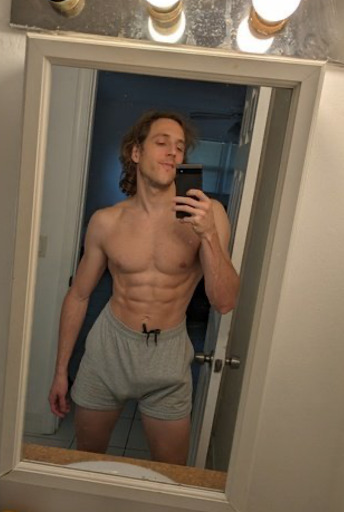
If the power flowing into him from the book filled him with pleasure, it was truly nothing compared to the energy and desire burning through his veins now. The clerk's eyes widen as the sound of fabric stretching emanates from Franklin’s crotch before being immediately followed by the loud tear of a zipper bursting off. He quickly looks away before seeing whatever has apparently burst from Franklin's pants as he stares at the man in shock.
The embarrassment only heightens Franklin's ecstasy, his clothes caress his powerful body as he feels his balls pulse as he feels them shift into overdrive, begging Franklin for release as they fill his barely hanging on briefs. Briefly keeping his lust at bay he looks up to see the clerk still in front of him and chokes back a grunt of hunger. His body flexes to pounce before he hesitates, god, he looks like he could be my kid. But that would- That can’t be right.
Before he can question any further he feels his balls grow even bluer as his cock begins to create rips in his underwear. Putting off his lust just long enough to avoid criminal charges he runs from the man who he could have sworn was his age, or his son’s age? His breath catches in his chest as he storms down the aisle. He feels his nipples scratch against his shirt as pre soaks through his increasingly torn briefs. He clenches his jaw to avoid moaning as he leaves a trail of sweat in his wake, barely making it inside the restroom and locking the door.
The cool air shocks his body as he holds his sweaty body against the door. Directly across from him is the mirror, seeing himself sets his hunger aflame higher than anybody can sustain. He sees his cock fully burst from his pants, sticking out straight from his crotch, the length he would’ve sworn his forearm was. Looking back to the mirror he flexes at himself and fully loses the ability to hold back. He moans as he cums without even touching his cock. His balls pulse as they continue producing five more loads to take the place of this one as he slides against the door, leaving a trail of sweat on the door as he moans and closes his eyes.
When he reopens them he finds himself in a thankfully different scene. There is no sign that he came all over the floor of a public restroom and he did not have a boner burst from his pants in front of that clerk. He’s been this horny his whole life, he knows how to handle himself. Fuck did he turn him on though. Franklin decides he needs to masturbate more, can’t be getting so horny for college hunks now that his son’s going to school. Fuck! He doesn’t have a son! Franklin knows something horrible is happening but before he can even start to make a connection he sees in front of him, precisely where he thought he came on the floor, his book. Lying open to a new page. He hasn’t the willpower to even feign resistance. He sees a powerful bear of a man. Franklin craves his power. He craves his virility. He needs to be more like him. He doesn’t even need to read the page opposite for it is already ingrained into him.
"A Real Father Is Mature."
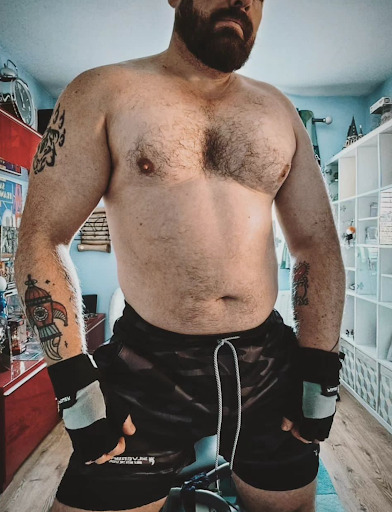
He burps as his tight abs quickly begin to soften and slightly bloat into what can only be described as a dad bod. He rubs his still growing stomach as his pubes inch above his waistline and shadow the whole of his torso. His body loses definition though he of course exercises to stay tight and strong as any real father should. He feels his hairline then as dark arm hair inches up towards his shoulders. He smirks as he reaches up to scratch at his ever-present stubble. Exposing his hairier pit to the fresh air, he laughs as his mind is filled with thousands of jokes, each worse than the last. You could say he’s Armed for every occasion he laughs as he flexes at himself in the mirror, each chuckle sounding deeper than the last.

Frank looks in the mirror ahead of him and feels and starts to chub up once more. He looks younger than he remembers being, although with each laugh at his own jokes his hair starts to grey and his forehead lines grow deeper. Each final change cementing him as a real father like the book suggests. He needs to go try these dad jokes out on an audience now. His son Jack would love to hear them.
Frank feels content looking at the book in front of him. This will be the perfect gift for his kid. This thing’ll make a dad out of anyone, lord knows it's worked wonders for him! Frank chuckles to himself, as his stubble grows out into a beard, thinking about whatever less-than-clever joke he’ll tell his son when he gives it to him as he heads out of the bookstore. He eyes the clerk that went to help him earlier as a hunger begins to build within Frank once more. The twink seems to be looking at a book on the shelf as if he’s never seen one before. He starts to reach out to its white cover as he thinks to himself, couldn’t hurt to see what’s inside.
274 notes
·
View notes
Text
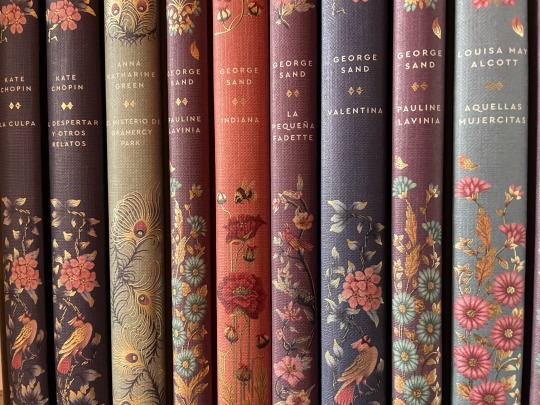
JOMP Book Photo Challenge || June || 1 || Introduce Yourself
Hi! My name is Deni and I am Mexican. I’m interested in reading all kinds of literature. However, I prefer fiction over non-fiction and narrative over poetry. My favorite genres are fantasy, mystery and horror.
#jompbpc#justonemorepage#bookshelf#book spines#shelfie#classic books#classic lit#louisa may alcott#george sand#kate chopin#my books#booklr#books#books and reading#leerreadinglire#book photo challenge
25 notes
·
View notes
Text
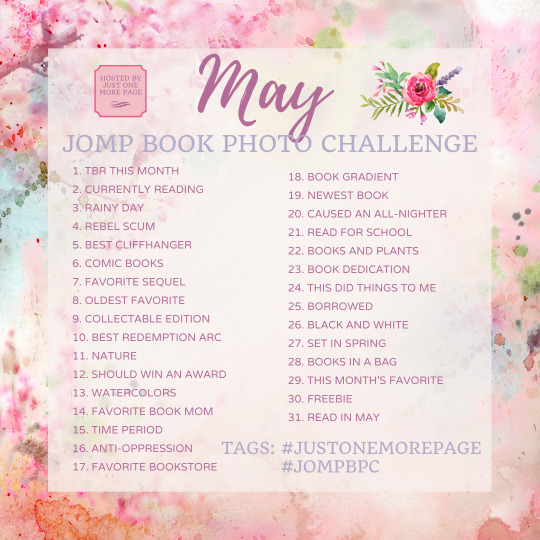
JOMP Book Photo Challenge hosted by Just One More Page 📚 📷
Month: May; Tags: #justonemorepage • #jompbpc
Sorry I missed posting this earlier, everyone! This month got away from me! But here's May's photo prompt, just in time for starting tomorrow. 🥰
As always, click here for the FAQ, and please feel free to ask me if you have any questions. ❤️ Enjoy!
38 notes
·
View notes
Text
A year in illustration, 2023 edition (part one)
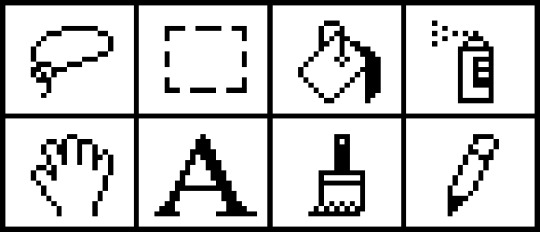
(This is part one; part two is here.)
I am objectively very bad at visual art. I am bad at vision, period – I'm astigmatic, shortsighted, color blind, and often miss visual details others see. I can't even draw a stick-figure. To top things off, I have cataracts in both eyes and my book publishing/touring schedule is so intense that I keep having to reschedule the surgeries. But despite my vast visual deficits, I thoroughly enjoy making collages for this blog.
For many years now – decades – I've been illustrating my blog posts by mixing public domain and Creative Commons art with work that I can make a good fair use case for. As bad as art as I may be, all this practice has paid off. Call it unseemly, but I think I'm turning out some terrific illustrations – not all the time, but often enough.
Last year, I rounded up my best art of the year:
https://pluralistic.net/2022/12/25/a-year-in-illustration/
And I liked reflecting on the year's art so much, I decided I'd do it again. Be sure to scroll to the bottom for some downloadables – freely usable images that I painstakingly cut up with the lasso tool in The Gimp.

The original AD&D hardcover cover art is seared into my psyche. For several years, there were few images I looked at so closely as these. When Hasbro pulled some world-beatingly sleazy stuff with the Open Gaming License, I knew just how to mod Dave Trampier's 'Eve Of Moloch' from the cover of the Players' Handbook. Thankfully, bigger nerds than me have identified all the fonts in the image, making the remix a doddle.
https://pluralistic.net/2023/01/12/beg-forgiveness-ask-permission/#whats-a-copyright-exception
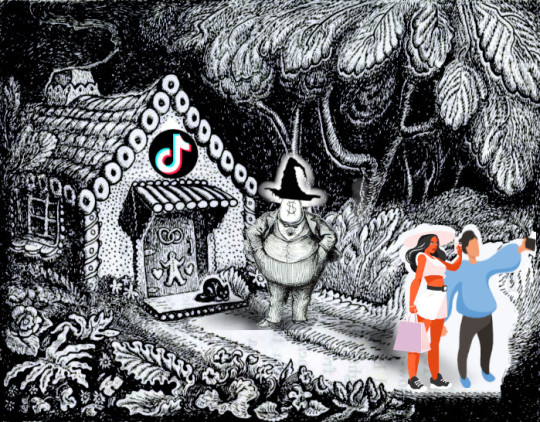
Even though I don't keep logs or collect any analytics, I can say with confidence that "Tiktok's Enshittification" was the most popular thing I published on Pluralistic this year. I mixed some public domain Brother's Grimm art, mixed with a classic caricature of Boss Tweed, and some very cheesy royalty-free/open access influencer graphics. One gingerbread cottage social media trap, coming up:
https://pluralistic.net/2023/01/21/potemkin-ai/#hey-guys
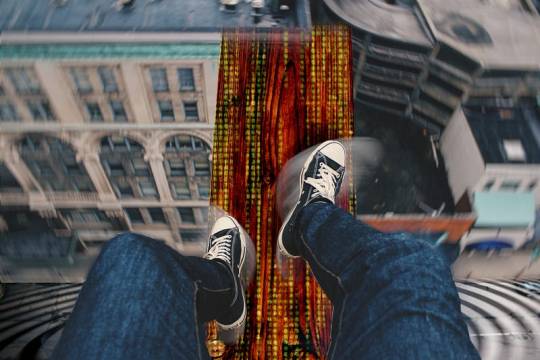
To illustrate the idea of overcoming walking-the-plank fear (as a metaphor for writing when it feels like you suck) I mixed public domain stock of a plank, a high building and legs, along with a procedurally generated Matrix "code waterfall" and a vertiginous spiral ganked from a Heinz Bunse photo of a German office lobby.
https://pluralistic.net/2023/01/22/walking-the-plank/

Finding a tasteful way to illustrate a story about Johnson & Johnson losing a court case after it spent a generation tricking women into dusting their vulvas with asbestos-tainted talcum was a challenge. The tulip (featured in many public domain images) was a natural starting point. I mixed it with Jesse Wagstaff's image of a Burning Man dust-storm and Mike Mozart's shelf-shot of a J&J talcum bottle.
https://pluralistic.net/2023/02/01/j-and-j-jk/#risible-gambit
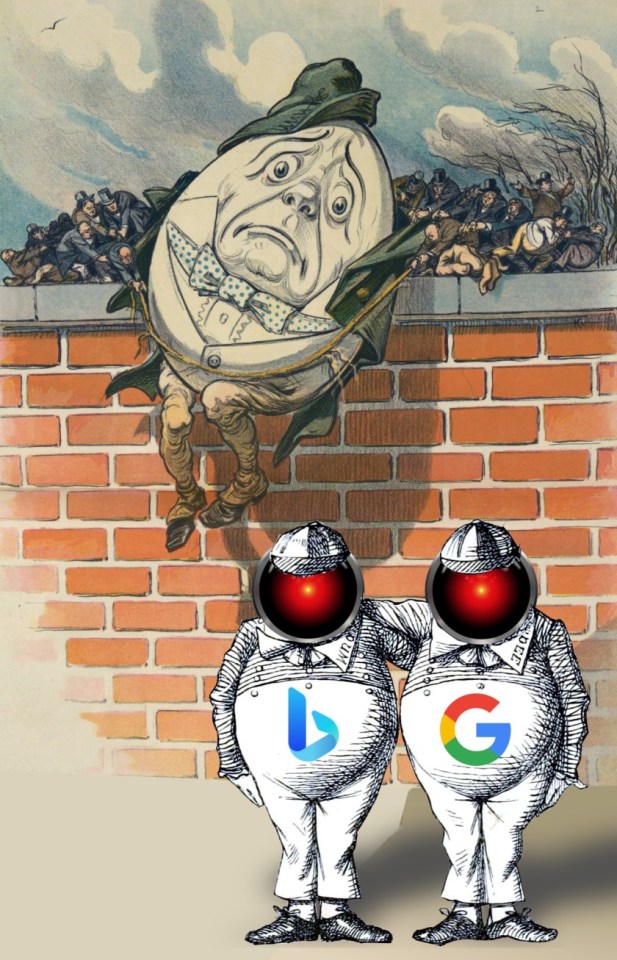
"Google's Chatbot Panic" is about Google's long history of being stampeded into doing stupid things because its competitors are doing them. Once it was Yahoo, now it's Bing. Tenniel's Tweedle Dee and Dum were a good starting point. I mixed in one of several Humpty Dumpty editorial cartoon images from 19th century political coverage that I painstakingly cut out with the lasso tool on a long plane-ride. This is one of my favorite Humpties, I just love the little 19th C businessmen trying to keep him from falling! I finished it off with HAL 9000's glowing red eye, my standard 'this is about AI' image, which I got from Cryteria's CC-licensed SVG.
https://pluralistic.net/2023/02/16/tweedledumber/#easily-spooked

Though I started writing about Luddites in my January, 2022 Locus column, 2023 was the Year of the Luddite, thanks to Brian Merchant's outstanding Blood In the Machine:
https://pluralistic.net/2023/09/26/enochs-hammer/#thats-fronkonsteen
When it came time to illustrate "Gig Work Is the Opposite of Steampunk," I found a public domain weaver's loft, and put one of Cryteria's HAL9000 eyes in the window. Magpie Killjoy's Steampunk Magazine poster, 'Love the Machine, Hate the Factory,' completed the look.
https://pluralistic.net/2023/03/12/gig-work-is-the-opposite-of-steampunk/

For the "small, non-profit school" that got used as an excuse to bail out Silicon Valley Bank, I brought back Humpty Dumpty, mixing him with a Hogwartsian castle, a brick wall texture, and an ornate, gilded frame. I love how this one came out. This Humpty was made for the SVB bailout.
https://pluralistic.net/2023/03/23/small-nonprofit-school/#north-country-school
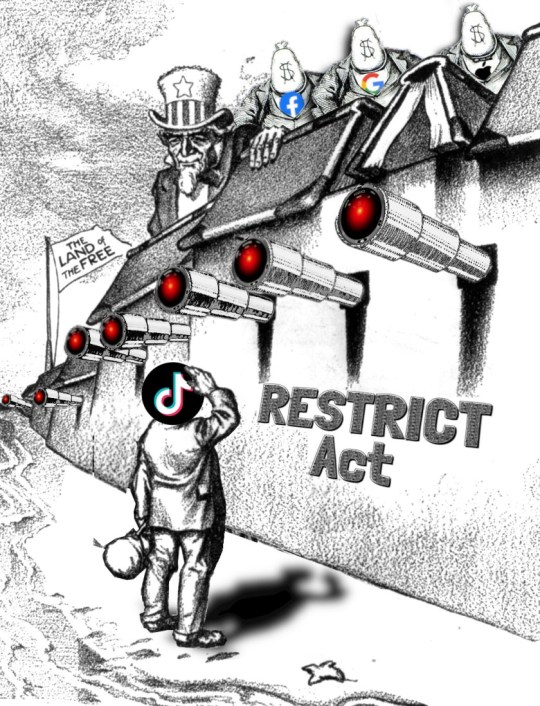
The RESTRICT Act would have federally banned Tiktok – a proposal that was both technically unworkable and unconstitutional. I found an early 20th century editorial cartoon depicting Uncle Sam behind a fortress wall that was keeping a downtrodden refugee family out of America. I got rid of most of the family, giving the dad a Tiktok logo head, and I put Cryteria's HAL9000 eyes over each cannonmouth. Three Boss Tweed moneybag-head caricatures, adorned with Big Tech logos, rounded it out.
https://pluralistic.net/2023/03/30/tik-tok-tow/#good-politics-for-electoral-victories
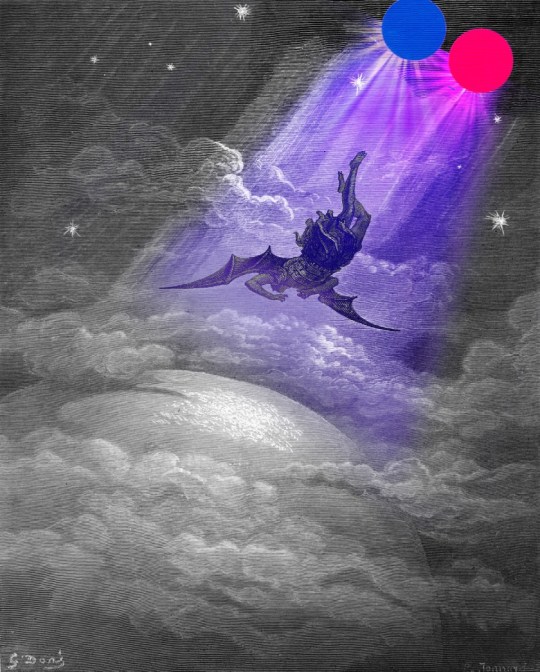
When Flickr took decisive action to purge the copyleft trolls who'd been abusing its platform, I knew I wanted to illustrate this with Lucifer being cast out of heaven, and the very best one of those comes from John Milton, who is conveniently well in the public domain. The Flickr logo suggested a bicolored streaming-light-of-heaven motif that just made it.
https://pluralistic.net/2023/04/01/pixsynnussija/#pilkunnussija

Old mainframe ads are a great source of stock for a "Computer Says No" image. And Congress being a public building, there are lots of federal (and hence public domain) images of its facade.
https://pluralistic.net/2023/04/04/cbo-says-no/#wealth-tax

When I wrote about the Clarence Thomas/Harlan Crow bribery scandal, it was easy to find Mr. Kjetil Ree's great image of the Supreme Court building. Thomas being a federal judge, it was easy to find a government photo of his head, but it's impossible to find an image of him in robes at a decent resolution. Luckily, there are tons of other federal judges who've been photographed in their robes! Boss Tweed with the dollar-sign head was a great stand-in for Harlan Crow (no one knows what he looks like anyway). Gilding Thomas's robes was a simple matter of superimposing a gold texture and twiddling with the layers.
https://pluralistic.net/2023/04/06/clarence-thomas/#harlan-crow

"Gig apps trap reverse centaurs in wage-stealing Skinner boxes" is one of my best titles. This is the post where I introduce the idea of "twiddling" as part of the theory of enshittification, and explain how it relates to "reverse centaurs" – people who assist machines, rather than the other way around. Finding a CC licensed modular synth was much harder than I thought, but I found Stephen Drake's image and stitched it into a mandala. Cutting out the horse's head for the reverse centaur was a lot of work (manes are a huuuuge pain in the ass), but I love how his head sits on the public domain high-viz-wearing warehouse worker's body I cut up (thanks, OSHA!). Seeing as this is an horrors-of-automation story, Cryteria's HAL9000 eyes make an appearance.
https://pluralistic.net/2023/04/12/algorithmic-wage-discrimination/#fishers-of-men
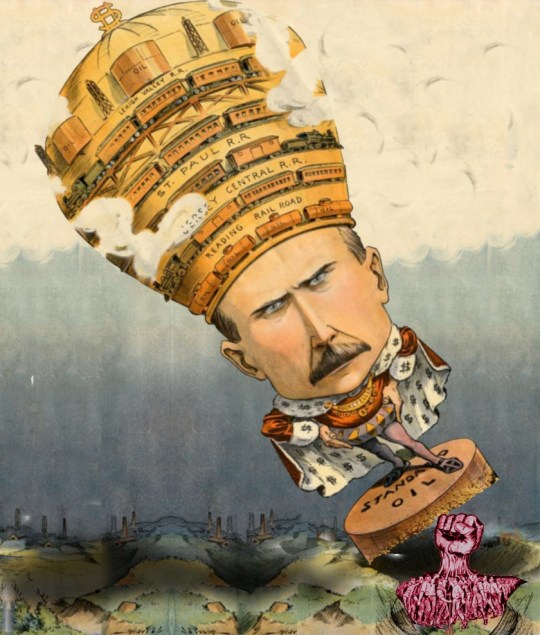
Rockefeller's greatest contribution to our culture was inspiring many excellent unflattering caricatures. The IWW's many-fists-turning-into-one-fist image made it easy to have the collective might of workers toppling the original robber-baron.
https://pluralistic.net/2023/04/14/aiming-at-dollars/#not-men
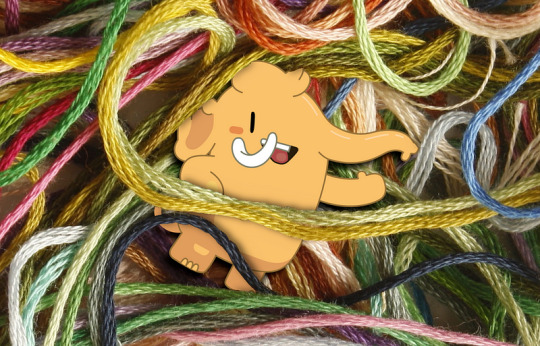
I link to this post explaining how to make good Mastodon threads at least once a week, so it's a good thing the graphic turned out so well. Close-cropping the threads from a public domain yarn tangle worked out great. Eugen Rochko's Mastodon logo was and is the only Affero-licensed image ever to appear on Pluralistic.
https://pluralistic.net/2023/04/16/how-to-make-the-least-worst-mastodon-threads/
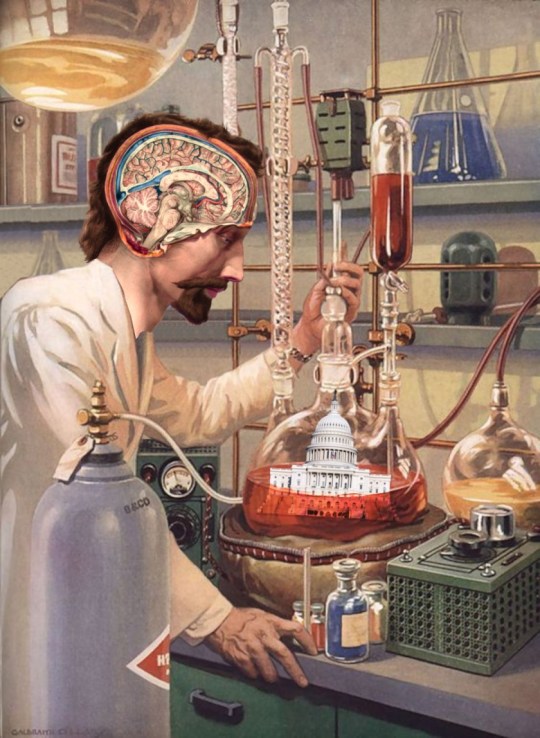
I spent hours on the sofa one night painstakingly cutting up and reassembling the cover art from a science fiction pulp. I have a folder full of color-corrected, high-rez scans from an 18th century anatomy textbook, and the cross-section head-and-brain is the best of the lot.
https://pluralistic.net/2023/05/04/analytical-democratic-theory/#epistocratic-delusions

Those old French anatomical drawings are an endless source of delight to me. Take one cross-sectioned noggin, mix in an old PC mainboard, and a vector art illo of a virtuous cycle with some of Cryteria's HAL9000 eyes and you've got a great illustration of Google's brain-worms.
https://pluralistic.net/2023/05/14/googles-ai-hype-circle/
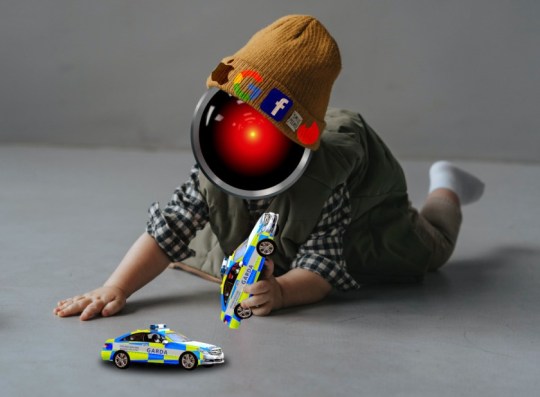
Ireland's privacy regulator is but a plaything in Big Tech's hand, but it's goddamned hard to find an open-access Garda car. I manually dressed some public domain car art in Garda livery, painstakingly tracing it over the panels. The (public domain) baby's knit cap really hides the seams from replacing the baby's head with HAL9000's eye.
https://pluralistic.net/2023/05/15/finnegans-snooze/#dirty-old-town
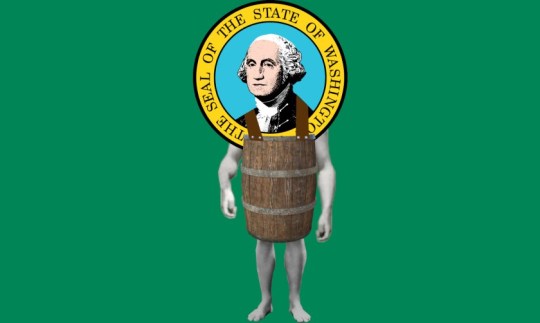
Naked-guy-in-a-barrel bankruptcy images feel like something you can find in an old Collier's or Punch, but I came up snake-eyes and ended up frankensteining a naked body into a barrel for the George Washington crest on the Washington State flag. It came out well, but harvesting the body parts from old muscle-beach photos left George with some really big guns. I tried five different pairs of suspenders here before just drawing in black polyhedrons with little grey dots for rivets.
https://pluralistic.net/2023/06/03/when-the-tide-goes-out/#passive-income
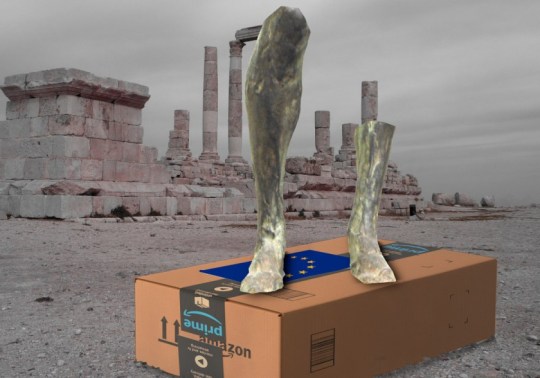
Illustrating Amazon's dominance over the EU coulda been easy – just stick Amazon 'A's in place of the yellow stars that form a ring on the EU flag. So I decided to riff on Plutarch's Alexander, out of lands to conquer. Rama's statue legs were nice and high-rez. I had my choice of public domain ruin images, though it was harder thank expected to find a good Amazon box as a plinth for those broken-off legs.
https://pluralistic.net/2023/06/14/flywheel-shyster-and-flywheel/#unfulfilled-by-amazon

God help me, I could not stop playing with this image of a demon-haunted IoT car. All those reflections! The knife sticking out of the steering wheel, the multiple Munsch 'Scream'ers, etc etc. The more I patchked with it, the better it got, though. This one's a banger.
https://pluralistic.net/2023/07/24/rent-to-pwn/#kitt-is-a-demon
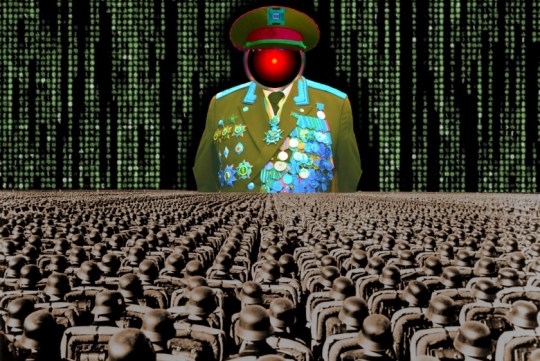
To depict a "data-driven dictatorship," I ganked elements of heavily beribboned Russian military dress uniforms, replacing the head with HAL9000's eye. I turned the foreground into the crowds from the Nuremberg rallies and filled the sky with Matrix code waterfall.
https://pluralistic.net/2023/07/26/dictators-dilemma/#garbage-in-garbage-out-garbage-back-in

The best thing about analogizing DRM to demonic possession is the wealth of medieval artwork to choose from . This one comes from the 11th century 'Compendium rarissimum totius Artis Magicae sistematisatae per celeberrimos Artis hujus Magistros.' I mixed in the shiny red Tesla (working those reflections!), and a Tesla charger to make my point.
https://pluralistic.net/2023/07/28/edison-not-tesla/#demon-haunted-world
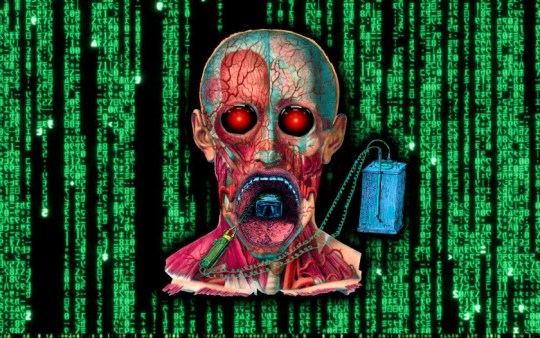
Yet more dividends from those old French anatomical plates: a flayed skull, a detached jaw, a quack electronic gadget, a Wachowski code waterfall and some HAL 9000 eyes and you've got a truly unsettling image of machine-compelled speech.
https://pluralistic.net/2023/08/02/self-incrimination/#wei-bai-bai

I had no idea this would work out so well, but daaaamn, crossfading between a Wachowski code waterfall and a motherboard behind a roiling thundercloud is dank af.
https://pluralistic.net/2023/08/03/there-is-no-cloud/#only-other-peoples-computers

Of all the turkeys-voting-for-Christmas self-owns conservative culture warriors fall for, few can rival the "banning junk fees is woke" hustle. Slap a US-flag Punisher logo on and old-time card imprinter, add a GOP logo to a red credit-card blank, and then throw in a rustic barn countertop and you've got a junk-fee extracter fit for the Cracker Barrel.
https://pluralistic.net/2023/08/04/owning-the-libs/#swiper-no-swiping

Putting the Verizon logo on the Hinderberg was an obvious gambit (even if I did have to mess with the flames a lot), but the cutout of Paul Marcarelli as the 'can you hear me now?' guy, desaturated and contrast-matched, made it sing.
https://pluralistic.net/2023/08/10/smartest-guys-in-the-room/#can-you-hear-me-now

Note to self: Tux the Penguin is really easy to source in free/open formats! He looks great with HAL9000 eyes.
https://pluralistic.net/2023/08/18/openwashing/#you-keep-using-that-word-i-do-not-think-it-means-what-you-think-it-means

Rockwell's self-portrait image is a classic; that made it a natural for a HAL9000-style remix about AI art. I put a bunch of time into chopping and remixing Rockwell's signature to give it that AI look, and added as many fingers as would fit on each hand.
https://pluralistic.net/2023/08/20/everything-made-by-an-ai-is-in-the-public-domain/
(Images: Heinz Bunse, West Midlands Police, Christopher Sessums, CC BY-SA 2.0; Mike Mozart, Jesse Wagstaff, Stephen Drake, Steve Jurvetson, syvwlch, Doc Searls, https://www.flickr.com/photos/mosaic36/14231376315, Chatham House, CC BY 2.0; Cryteria, CC BY 3.0; Mr. Kjetil Ree, Trevor Parscal, Rama, “Soldiers of Russia” Cultural Center, Russian Airborne Troops Press Service, CC BY-SA 3.0; Raimond Spekking, CC BY 4.0; Drahtlos, CC BY-SA 4.0; Eugen Rochko, Affero; modified)
#pluralistic#illustration#collage#fair use#creative commons#stock art#blogging#art#practice makes perfect
231 notes
·
View notes
Photo
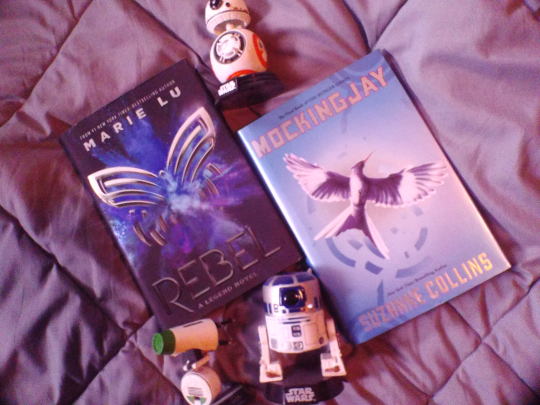
April 2023 JOMPBPC: Day 4 Rebel Scum
#justonemorepage#jompbpc#book photo challenge#booklr#bookblr#books#funko pop#funko and books#rebel#marie lu#Suzanne Collins#mockingjay#may 2023
15 notes
·
View notes
Text
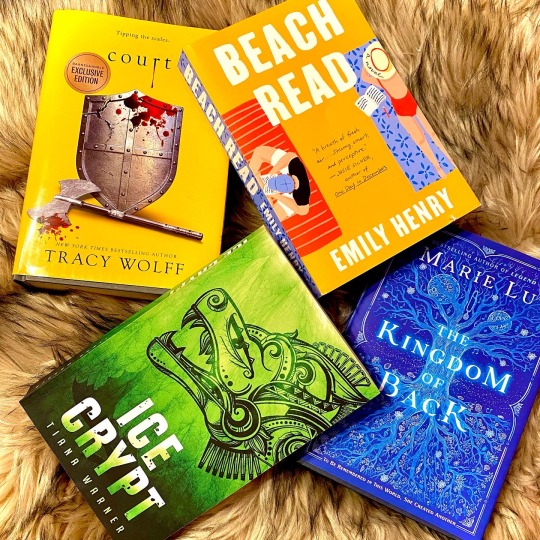


JOMP day 31
Read in May
Not too many physical books & so many audiobooks I had to make 2 slides for my digital wrap up 😅
But overall I enjoyed the majority of the books so 🙌
5 notes
·
View notes
Text
75 DAYS HARD CHALLENGE: DAY I
Previously I announced that I will begin the 75 Days Hard Challenge at the first of July. For anyone unfamiliar, the Challenge takes 75 Days and follows these daily rules:
Choose a diet and follow it (without cheat meals or alcohol)
Complete two 45-minute workouts daily (one needs to be outside no matter the weather)
Drink a gallon of water every day
Read 10 pages of nonfiction
Take progress pictures
If you skip or miss a task you must start over
Things you should know:
I decided to try this challenge because I want to improve my mental toughness and physical fitness (also I want to prove to myself that I am consistent). It's probably not for everyone, so there is also a soft version of this challenge called 75 Days Soft Challenge.
I prepared for this challenge a month in advance. I tried out what diet suits me the most without craving cheat meals, decided on what books I want to read and what kind of workouts are the best for me.
I don't want to bother you with a daily follow up of my challenge, but please consider I'll try to do an update every 1-2 weeks.
"All great things have small beginnings."
My current routine on this challenge varies from day to day because I do work shifts but there are a few things that stay consistent during this challenge:
Diet:
I decided to do IF with a 16:8 ratio. I start eating at 10am and have my last meal at 6pm. Mostly low carb, high protein. No meat, no sugar, limited dairy. Please consider that every human is different and what may work for me, won't do it for you. I decided to become vegetarian a month ago and I don't regret it yet.
2. Workouts:
I am not an athlete. Therefore two heavy workouts a day would cause me injuries. I'm taking a 45 minutes outdoor walk everyday and the second workout is whatever suits my day the most. For example on Mondays I'm going to a yoga class, therefore this will be my second workout.
3. Hydration:
To be honest, I had to change this one a bit. I'm drinking one black coffee every morning and I'm also having a tea before I go to sleep. This intake plus a gallon of water would be too much for my body. I decided to drink 3 Liters of water everyday and the missing 0,7 liters will be tea and black coffee. I'm not drinking anything else for the duration of this challenge. No soft drinks, no alcohol, no milk (except for coconut milk for my overnight oats).
4. my non-fiction reading list:
Patrick Lencioni - The Five Dysfunctions of a Team
Dale Carnegie - How to Win Friends and Influence People
Yuval Harari - Homo Deus
Yuval Harari - 21 Lessons for the 21 Century
Daniel Kahneman - Thinking Fast and Slow
James Clear - Atomic Habits
Robert Greene - The 48 Laws of Power
Robert Greene - The Art of Seduction
Erich Fromm - The Art of Loving
Oliver Burkeman - Four Thousands Weeks
James Carse - Finite and Infinite Games
Seneca - Letters from a Stoic
Plato - Allegory of the Cave
5. last but not least - the progress picture:
I hate taking pictures, so I won't really share them but I made a folder on my phone and taking the photo is the first thing I'm doing in the morning to get it off my list.
Bisous!


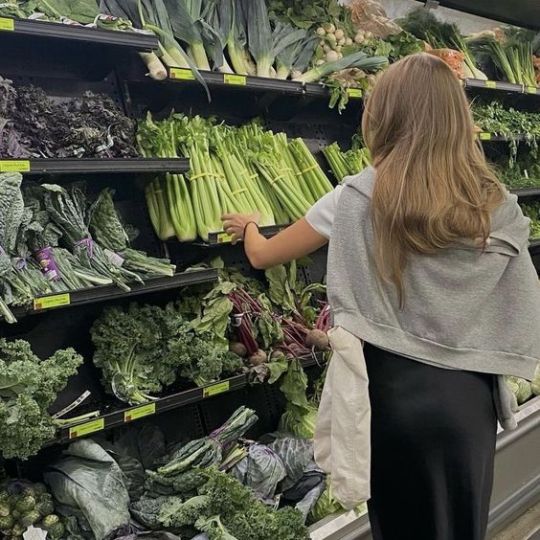
#that girl#self care#clean girl#green juice girl#routine#pink pilates princess#it girl#glow up#habits#75 hard#75 days#75 days hard challenge#challenge#tw: dieting#tw: diet#intermittent diet#diet#diet and fitness#healthy eating#nutrition#fitness#workout
674 notes
·
View notes